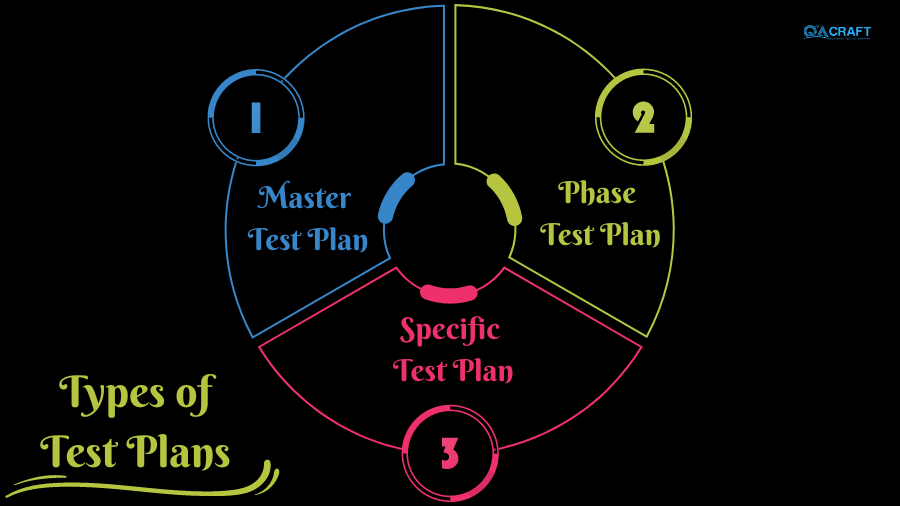29 Nov

A test plan often lists the requirements, risks, test cases, testing environments, business and quality objectives, test timelines, and other things.
What is a Test Plan?
The strategy, goals, timetable, estimation, deliverables, and resources needed to carry out testing on a software product are all described in detail in a test plan. The test plan aids in estimating the amount of work required to verify the application’s quality. The test manager carefully monitors and controls every aspect of the test plan to ensure that software testing activities are carried out according to a defined methodology.
Types of Test Plans
- Master Test Plan
- Phase Test Plan
- Testing Type-Specific Test Plans

Master Test Plan
A test plan with many tiers of testing is called a master test plan. It has an entire test plan.
Phase Test Plan
One sort of test plan that addresses each element of the testing technique is a phase test plan. For instance, a list of test cases, a list of tools, etc.
Specific Test Plan
A specific test plan for major testing types like security testing, load testing, and performance testing, among others that is, a particular non-functional testing-specific test plan.
What is the Importance of a Test Plan?
There are numerous advantages to creating a test plan document, including assisting customers, business managers, and developers outside of the test team in comprehending the specifics of testing.
Our thinking is guided by the Test Plan. It is like a set of rules that must be followed.
The Test Plan contains important details like test estimation, test scope, and test strategy so that it can be reviewed by the Management Team and used again for other projects.
How to write a Test Plan?
For the management team, the critical task is to make a test plan. Below steps are as follows:

- Analyze the product
Testing the product without any knowledge is next to impossible. One should learn about the product before testing it. You should look around the website and read the documentation for the product. You can learn how to use the website and all of its features by reading the product documentation. If you’re not sure about anything, you could talk to a customer, a developer, or a designer to learn more.
- Develop a Test Strategy
In software testing, developing a Test Plan begins with developing a Test Strategy. A high-level document known as a Test Strategy is typically created by the Test Manager. This document explains:
The testing effort and costs are determined by the project’s testing objectives and methods. The below steps should be followed:
A. Define the Scope of Testing
Precise customer requirements, a project budget, product specifications, and the talents and skills of your test team are all necessary for determining the scope.
B. Identify the Testing Type
A typical test procedure with an anticipated outcome is referred to as a Testing Type.
Each type of testing is designed to find a particular kind of product bug. However, the objective of all testing types is the same: “Early detection of all defects before releasing the product to the customer.”
C. Document Risk & Issues
Risk is an uncertain future event that has a chance of happening and the potential to lose money. When the risk occurs, it becomes the “problem.”
D. Create Test Logistics
The Test Manager should respond to the following questions in Test Logistics:
- Who will examine it?
Although the tester’s precise names may not be known, the type of tester can be identified.
- When will the test take place?
Development activities must be matched to test activities.
- Define the Test Objective
The overall objective and level of achievement of the test execution are the Test Objectives. The testing aims to uncover as many software flaws as possible; before releasing the software under test, make sure it doesn’t have any bugs.
The following two steps should be taken to define the test objectives:
- List all software features ( that might need to be tested.
- Using the aforementioned characteristics, define the test’s objective or target.
- Define Test Criteria
A standard or rule that a test procedure or test judgment can be based on is called Test Criteria. Two types of test criteria are:-
Suspension Criteria: Describe the essential suspension requirements for a test. The active test cycle will be suspended until the suspension criteria are resolved if they are met during testing.
Exit Criteria: It defines the criteria for a test phase’s successful completion. Before moving on to the subsequent development phase, the exit criteria—the intended test results—are required. Example: All critical test cases must pass 95% of the time.
- Resource Planning
A resource plan is a comprehensive list of all the resources necessary to complete a project task. The number of resources (employees, equipment, and materials) required to complete a project can be determined with the assistance of resource planning, which is an important part of the test planning process. As a result, the Test Manager can accurately estimate the project’s schedule and budget.
- Plan Test Environment
A set of software and hardware on which the testing team will run test cases is called a testing environment. Real business and user environments, in addition to physical environments like servers and front-end running environments, make up the test environment.
- Schedule & Estimation
A common term in project management is “making a schedule.”The Test Manager can use Test Planning as a tool for monitoring project progress and controlling cost overruns by creating a solid schedule.
Deadline for employee and project: The schedule is affected by working days, the project’s deadline, and the availability of resources.
Estimating the project: The Test Manager is aware of the project’s completion time based on the estimate So that he can make the right schedule for the project
Project Threat: Because the Test Manager is aware of the risk, he or she can add sufficient additional time to the project schedule to address it.
- Test Deliverables
A list of all the documents, tools, and other parts that need to be made and kept up to support the testing effort is called a Test Deliverable.
After the testing cycles have ended, test deliverables are provided.
Defect Report, Installation/Test Procedures Guidelines, Release Notes, and Test Reports.
Test plan components or attributes
Scope: Explains in detail what the project’s goals are. Additionally, it describes test-applicable user scenarios. The scope can specify, if necessary, which scenarios or issues the project will not address.
Schedule: Specifies the start dates and due dates by which testers must deliver results.
Resource distribution: Explains which test will be worked on by which tester.
Environment: Explains the test environment’s nature, configuration, and availability in detail.
Tools: Explains the tools that will be used for testing, bug reporting, and other activities that are pertinent.
Management of Defects: Explains how and to whom bugs will be reported, as well as what each bug report must include. Should bugs be reported with screenshots, text logs, or videos of where they occur in the code, for instance?
Management of risk: Explains the risks associated with software testing and the risks associated with the software itself if it is released without adequate testing.
Parameters of exit: Specifics regarding when testing must cease. This section provides testers with a benchmark against which to compare actual results by describing the expected outcomes of the QA operations.
Conclusion:
Requirements, risks, test cases, test environments, business and quality goals, test schedules, and other details are typically outlined in a test plan. A nested master-child relationship can be used to group together test plans that are related.
Read Also:
Risha works as a QA engineer at QACraft. She is a computer science engineer and has 2+ years of experience in manual and automation testing. In her free time, she loves to indulge in books and make paintings
Related Post
Categories
- Agile Testing
- Agile Testing
- Android App Testing
- Automation Testing
- Banking Domain Testing
- Beta Testing
- cloud testing
- Corporate Life
- cross browser testing
- Cypress Testing
- Cypress Testing
- desktop testing
- Domain Testing
- E-commerce Website Testing
- E-learning App Testing
- Functional Testing
- Game Testing
- Healthcare Domain Testing
- Infographics
- Ios App Testing
- Jenkins
- JIRA
- Katalon
- Manual Testing
- Mobile App Testing
- monkey testing
- Performance Testing
- Regression Testing
- Salesforce Testing
- security testing
- Selenium
- Selenium
- Software Testing
- static testing
- Test Environments
- vdfv
- Web Application Testing
© Copyright 2024 QACraft Pvt. Ltd. All rights reserved.
Contact : +91 9157786796



Risha Bhat